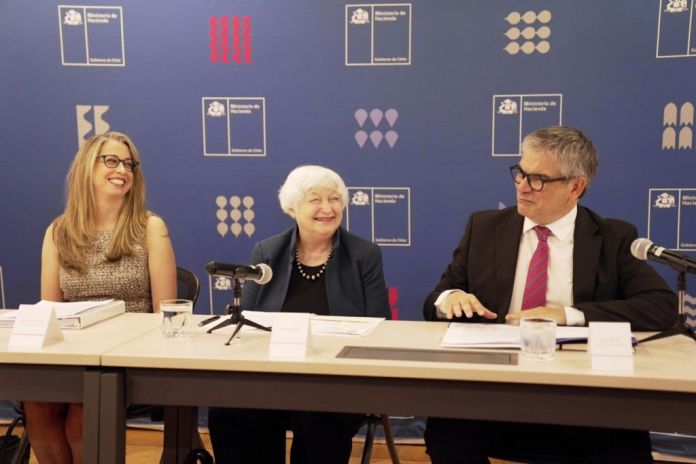- Secretary of the Treasury Janet L. Yellen at Albemarle Corporation’s Lithium Processing Facility in Antofagasta, Chile
By Janet L. Yellen
- US-Chile economic relations
Last year, the United States and Chile marked the bicentennial of our diplomatic relations. This year, we celebrate the twentieth anniversary of the US-Chile Free Trade Agreement, which fuels mutual economic benefit. US. exports to Chile created over 70,000 American jobs in 2021 and the U.S. invested nearly $30 billion in Chile in 2022.
Just last December, extensive cooperation between the US Treasury Department and Chile’s Ministry of Finance culminated in a comprehensive bilateral tax treaty between the US and Chile entering into force. This is the first such treaty signed by the US to enter into force in over a decade. It will further reduce tax-related barriers to cross-border investment, facilitating even stronger economic ties between our countries.
In my remarks [today], I’d like to focus on one key aspect of the US-Chile economic relationship that is only becoming more important: our work to build green and resilient supply chains. The United States is lowering energy costs, advancing our energy security, and combatting climate change through both investing at home and strengthening relationships with key partners like Chile. We are eager to build on this foundation going forward.
Our partnership on energy security and climate
President Biden and I have been focused on advancing our energy security. When energy prices are volatile, families around the world, including in the US and Chile, shoulder the burden of high costs and unpredictability. These shocks add significant financial stress to households trying to make ends meet and to businesses trying to thrive and scale.
We’ve coordinated with our allies and partners to mitigate external price shocks and keep costs down. When Russia invaded Ukraine, we responded quickly and decisively. At home, we released 180 million barrels from the Strategic Petroleum Reserve. Over time, record domestic oil and natural gas production also addressed our immediate needs. With a coalition of partners, we put in place a price cap on Russian oil. The price cap has deprived Russia of revenue while keeping energy markets well-supplied. Energy prices have declined, with gas now down around $1.70 per gallon from its high in June 2022 and global crude oil prices down around $40 per barrel since then.
Around the world, the increasing frequency and severity of climate-related events also undermines energy security and has far-reaching economic impacts. Last month, California witnessed record floods, with several counties under a state of emergency. At the same time, devastating wildfires swept through Chile, destroying whole neighbourhoods and leading to tragic loss of life. Climate change poses a threat to all of us. While we remain committed to pursuing short-term actions to lower energy costs, in the longer term, it’s the transition to clean energy that offers a pathway to both greater energy security and combatting the devastating effects of climate change.
In the United States, the Bipartisan Infrastructure Law and the Inflation Reduction Act are helping drive progress. The Inflation Reduction Act provides tax credits to help American households make energy-efficiency improvements, allowing Americans to shrink and stabilize their energy bills right away. It’s also reinvigorating American manufacturing – creating well-paying jobs and fueling innovation. Companies have announced over $600 billion in manufacturing and clean energy investments since the start of this administration. We’re seeing investments in places like Bessemer City, North Carolina, where I travelled this fall to see our country’s largest lithium hydroxide production facility. The cutting-edge lithium products being produced there will power America’s electric vehicle supply chain.
And our investments at home won’t only impact energy production in the United States. Because it’s now cheaper to produce clean energy, production will increase and costs will drop more. This will make clean energy even more affordable – not only for Americans, but for Chileans and others around the globe.
But we know that the United States can’t bolster our energy security or advance our climate agenda alone.
Parts of our key supply chains, including for clean energy, are currently over-concentrated in China. This makes America more vulnerable to shocks in China, or whatever country dominates production, from natural disasters to macroeconomic forces, to deliberate actions such as economic coercion. So, alongside investing at home, we’re pursuing an approach I’ve called friendshoring: bolstering our supply chains through strengthening our relationships with our key partners and allies.
Chile is one of those key partners. As we accelerate toward a clean energy future, our already strong economic relationship is poised for further strengthening.
Copper is key to the transition to net zero, from electric vehicles to offshore wind turbines to transmission networks. If the world aims to achieve net-zero by 2050, demand for copper is projected to double by 2035. And Chile leads global production, with copper its top export.
Chile is also the world’s second-biggest producer of lithium, with 30 percent of global market share and the largest lithium reserves on earth. Like for copper, demand for lithium is expected to grow due to its key role in energy storage, such as for EV batteries. In fact, lithium demand is projected to more than triple by 2030.
As the United States and other countries grow our EV markets and invest more and more in renewables, Chile will play a key role. Our Free Trade Agreement with Chile means that critical minerals from Chile help vehicles qualify for the Inflation Reduction Act’s Clean Vehicle Tax Credit, boosting industries in both Chile and America.
Where we are today is a perfect example of our mutually beneficial economic ties. Albemarle is headquartered in North Carolina and has a production site in Salar de Atacama and this conversion plant in La Negra. The company employs more than 1,000 workers in Chile, over 75 percent of whom are from the region. It also recently launched an apprenticeship program to expand pathways into these jobs. Our ties with Chile increase our energy security at home, create economic opportunity in both our countries, and bring us all closer to achieving our climate goals.
In the medium- to long-term, we’ll see shifts as we ramp up lithium production in the United States. Albemarle plans to reopen its lithium mine in North Carolina by 2030, capitalizing on Bipartisan Infrastructure Law funds and IRA tax credits. In Nevada, construction for a mine and processing facility has been underway since last March. But the global need for clean energy means there’s ample demand for both Chile and the US to meet it. Researchers have estimated that there are over $3 trillion in global investment opportunities associated with the transition to net zero each year between now and 2050.
President Biden and I are dedicated to further shoring up our bilateral cooperation and enabling both the US and Chile to capitalize on these opportunities.
Chile’s climate agenda
I am also very impressed by Chile’s [own] ambitious climate agenda. Chile is leading the way on sustainable finance as the region’s first sovereign green bond issuer and the world’s first sovereign sustainability-linked bond issuer. It has one of the world’s greenest grids. Approximately sixty percent of its power comes from zero-carbon sources, including over a quarter generated by wind and solar.
Chile has also put in place tax support for EV buyers and aims to reach 100 percent in EV sales by 2035. And it may well lead the way in green hydrogen, with more than 40 green hydrogen projects underway.
All of this makes Chile exactly the kind of partner we need in the transition to clean energy.
Conclusion
Indeed, the actions the United States and Chile are each taking and those that we’re taking together are driving progress. This year, the US will continue investing at home and in supply chains that benefit both the U.S. and Chile. And around the world, other efforts, from Just Energy Transition Partnerships to support emerging markets to Chile’s leadership will bring us closer to the future we need for the generations to come.







